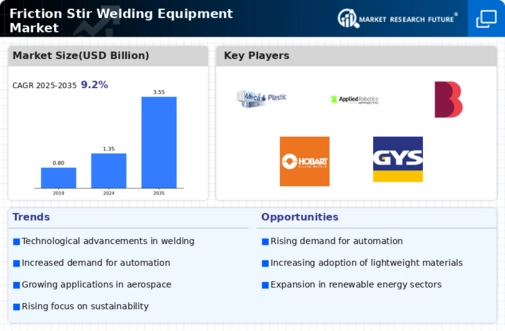Diverse Applications Across Industries
The versatility of friction stir welding technology is a key driver in the Friction Stir Welding Equipment Market. This method is applicable across various sectors, including automotive, aerospace, and shipbuilding, where strong, lightweight joints are essential. The automotive industry, in particular, is increasingly adopting friction stir welding for manufacturing lightweight components, which is crucial for enhancing fuel efficiency. Additionally, the aerospace sector benefits from the ability to weld dissimilar materials, which is vital for modern aircraft design. As industries continue to explore innovative applications, the demand for specialized friction stir welding equipment is likely to expand. Market analysts project that the increasing adoption of this technology in diverse applications could lead to a significant rise in market value, potentially exceeding USD 500 million by 2027.
Rising Demand for Lightweight Materials
The rising demand for lightweight materials is significantly influencing the Friction Stir Welding Equipment Market. Industries such as automotive and aerospace are increasingly utilizing materials like aluminum and magnesium to enhance performance and fuel efficiency. Friction stir welding is particularly well-suited for these materials, as it provides strong joints without compromising their lightweight properties. As manufacturers strive to meet regulatory standards for emissions and fuel consumption, the adoption of friction stir welding technology is likely to increase. Market forecasts indicate that the demand for lightweight materials will continue to grow, potentially leading to a market expansion for friction stir welding equipment. This trend underscores the importance of friction stir welding in facilitating the transition to more efficient and sustainable manufacturing practices.
Sustainability Initiatives Driving Demand
In the Friction Stir Welding Equipment Market, sustainability initiatives are becoming increasingly pivotal. The shift towards environmentally friendly manufacturing processes is prompting industries to adopt friction stir welding due to its energy efficiency and minimal waste generation. This method produces less thermal distortion and requires less energy compared to traditional welding techniques, aligning with global sustainability goals. As manufacturers strive to reduce their carbon footprint, the demand for friction stir welding equipment is expected to grow. Reports suggest that the market could witness a compound annual growth rate of over 5% in the coming years, driven by the need for sustainable practices. Consequently, companies that prioritize eco-friendly solutions are likely to gain a competitive edge, further propelling the market forward.
Growing Investment in Manufacturing Infrastructure
Investment in manufacturing infrastructure is a notable driver for the Friction Stir Welding Equipment Market. As countries focus on enhancing their manufacturing capabilities, there is a growing emphasis on adopting advanced welding technologies. Governments and private sectors are channeling funds into upgrading facilities and incorporating state-of-the-art friction stir welding equipment. This trend is particularly evident in regions where manufacturing is a key economic driver. The establishment of new manufacturing plants and the modernization of existing ones are expected to create substantial demand for friction stir welding solutions. Furthermore, the increasing trend of reshoring manufacturing activities is likely to bolster the market, as companies seek to improve production efficiency and reduce lead times. This investment momentum suggests a promising outlook for the friction stir welding equipment market.
Technological Advancements in Friction Stir Welding Equipment
The Friction Stir Welding Equipment Market is experiencing a surge in technological advancements that enhance welding efficiency and quality. Innovations such as automated systems and real-time monitoring technologies are being integrated into welding equipment, allowing for improved precision and reduced operational costs. The introduction of advanced materials and welding techniques is also contributing to the market's growth. For instance, the development of hybrid welding systems that combine friction stir welding with traditional methods is gaining traction. This evolution in technology not only increases the versatility of applications but also expands the potential customer base. As industries seek to optimize production processes, the demand for cutting-edge friction stir welding equipment is likely to rise, indicating a robust growth trajectory for the market.


















Leave a Comment